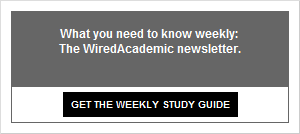Domestic, Education Quality, For-Profit, Gainful Employment, Graduation Rates, Legislation, Opinion, Regulatory, Required, Unemployment, Universities & Colleges - Written by Wired Academic on Sunday, November 11, 2012 21:50 - 0 Comments
Columnist Ryan Craig: Jobs, Capabilities & The Upcoming Digital Divide
Jobs, Capabilities and the New Digital Divide
By Ryan Craig, Columnist
If the presidential election was about one thing, it was jobs. A few numbers stand out from the campaign: 23 million unemployed, an unemployment rate that has remained over 7% since the last election, and finally 3.7 million unfilled jobs.
America remains exceptional in many ways, but unfilled jobs is not one of them. Other countries fare as poorly or worse in identifying and preparing workers to meet the needs of employers. According to a survey earlier this year of over 38,000 employers in 41 countries, 34% of companies worldwide reported finding it hard to fill open positions. In the survey by Manpower, the recruitment firm, Japan leads the world at 81%. Brazil is at 71%. Then Australia at 50% and the U.S. at 49%. Not surprisingly, a survey of 302 employers conducted in 2010 by Hart Research concluded that only one in four U.S. employers think that colleges and universities are doing a good job preparing students for the workplace.
If you ask, employers are more than happy to provide a laundry list of capabilities that students lack. Employers have a set of expected or target capabilities that are not being met. The list of macro-capabilities is, in rough order of priority: better written communication skills; better verbal communication skills; critical thinking; and complex problem solving. For the most difficult positions to fill – skilled trades, sales representatives and engineers (a position 88% of American companies report as somewhat or very difficult to fill) – employers have sets of micro-capabilities that go wanting.
Students need to up their game to meet these target capabilities. How should we think about this challenge? The literature of performance management is clear: the key to transforming actual behaviors to target behaviors is to set short-term goals as milestones on the road to the target, and then accurately and regularly document progress. If milestones are met, keep going. If they’re not being met, try new and different approaches. Rinse and repeat.
Failure to improve capability alignment between students and employers will create harm and hardship for both. But universities will be the ones held to account. This is particularly true because we now have the means to define, document and track capabilities, and the lion’s share of that can be done by universities.
Transcripts, curricula and job descriptions seem like unrelated documents, but they’d be a lot more useful if they were intricately related. At present, there is little connection. Online career sites such as Monster have job postings with employer descriptions and job requirements. Yet bland banner ads directing job seekers to a business degree aren’t helping anyone. As we described in a prior letter, transcripts should document actual capabilities and for graduates, reflect the capabilities a graduate of that program should be expected to demonstrate (based on the learning outcomes associated with each course). Meanwhile, job descriptions should detail what capabilities a position requires.
Relating transcripts and curricula to job descriptions will require bottoming all on the same taxonomy – a taxonomy of capabilities. This means that universities and employers agree on a standard set of thousands of capabilities that can be applied equally to learning outcomes, courses, degree programs, and job descriptions.
The taxonomy will be most effective when individuals are able to view their portfolio of capabilities in real time and compare them to the target capabilities prescribed by employers for their ideal jobs. Then they’ll be able to choose the courses or programs that should help them most efficiently and effectively transform their actual capabilities into target capabilities. And they’ll be able to track their progress, by semester, by month, or even more frequently.
If adopted broadly across higher education and the economy, a taxonomy of capabilities has the potential to fill unfilled jobs and generally improve the productivity of labor. As productivity gains derived from technology adoption decline, this is one area where we will make up lost ground.
***
Sounds great, right? The challenge is putting it into practice and doing so at scale. The only plausible path requires technology: making the taxonomy of capabilities a metadata standard, tagging every learning outcome, course, program and job description; and making all documents – transcripts, curricula, and job descriptions – machine readable.
While it is far-fetched to imagine a university tagging learning outcomes, curricula and transcripts with capabilities metadata (and making these documents machine readable) for its campus-based programs, it’s not hard to imagine some beginning to do so in the coming years with their online programs. Online programs already have these documents in digital format, and online competency-based programs like Western Governors and University now point the way to capabilities metadata tagging.
As a result, we will see capability alignment between students and employers much sooner for students learning entirely online than for students learning on campus or through blended models. This will be the new digital divide: students learning online will have the ability to select more efficient and effective paths to transforming their actual capabilities to the target capabilities required by employers, and then to track their progress.
Not only will online students have an advantage in being able to document their capabilities in terms of the metadata attached to their online transcripts, but also in terms of online portfolios. As assessments and assignments will also be tagged with capabilities metadata, online students will have developed portfolios of work that demonstrate exactly the capabilities employers are seeking. So employers won’t have to take universities’ word for it. They’ll be able to see it for themselves. (Of course, this also help opens the door to new providers of education – it won’t have to be a brand-name or even accredited university if the capabilities-tagged work is visible to employers via an open portfolio.)
The new digital divide will segment higher education providers into jobs-focused and employer-friendly institutions (i.e., online) and traditional campus-based institutions. It will also further accelerate the adoption of online learning and result in online taking additional market share from campuses for both adult learners and traditional age students. Such is the transformative price higher education will pay to do a better job of transforming students into capable employees.
Ryan Craig is a Partner at University Ventures, a venture fund focused on innovation from within higher education.
Campus Buzz
We welcome Tips & Pitches
Latest WA Original Features
-
“Instreamia” Shakes Loose Moss By Launching Spanish Language Mini-MOOC
-
Jörn Loviscach: A German Math Teaching Sensation Emerges On YouTube & Udacity
-
Open University Enters Battle Of The MOOCs, Launches “FutureLearn”
-
Alvaro Salas As A Case Study In Crowd-Funding An Ivy-League Education
-
Jonathan Mugan: How To Build A Free Computer Within A Computer For Your Child
Paul Glader, Managing Editor
@paulglader
Eleni Glader, Policy Editor
Elbert Chu, Innovation Editor
@elbertchu
Biagio Arobba, Web Developer
@barobba
Contributors:
Michael B. Horn
@michaelbhorn
Derek Reed
@derekreed
Annie Murphy Paul
@AnnieMurphyPaul
Frank Catalano
@FrankCatalano
Ryan Craig
@UniVenturesFund
Jonathan Mugan
@JMugan
Terry Heick
@TeachThought
Alison Anderson
@tedrosececi
Ravi Kumar
@ravinepal

The Pulitzer Prize winning investigation newsroom digs into for-profit education.
-
Most Viewed
- Inside Ashford University: A former staffer talks to WiredAcademic
- Infographic: A History Of Information Organization From Stone-Age To Google
- Davos: 12-Year-Old Pakistani Prodigy Girl Talks About Her Online Learning
- Open University Enters Battle Of The MOOCs, Launches "FutureLearn"
- Pearson Llc + Google Expands LMS Business With "OpenClass" System
-
MARKET INTRADAY SNAPSHOT
- Education & Tech Companies We Follow
| APEI | 40.20 |  -0.17 -0.17 |  -0.42% -0.42% | ||
| APOL | 19.01 |  +0.33 +0.33 |  +1.77% +1.77% | ||
| AAPL | 460.16 |  -6.43 -6.43 |  -1.38% -1.38% | ||
| BPI | 10.74 |  -0.09 -0.09 |  -0.83% -0.83% | ||
| CAST | 0.11 |  +0.01 +0.01 |  +10.00% +10.00% | ||
| CECO | 4.08 |  -0.02 -0.02 |  -0.49% -0.49% | ||
| COCO | 2.40 |  -0.02 -0.02 |  -0.83% -0.83% | ||
| CPLA | 32.03 |  -0.41 -0.41 |  -1.26% -1.26% | ||
| DV | 30.69 |  +0.36 +0.36 |  +1.19% +1.19% | ||
| EDMC | 4.03 |  +0.07 +0.07 |  +1.77% +1.77% | ||
| ESI | 18.34 |  +0.04 +0.04 |  +0.22% +0.22% | ||
| GOOG | 792.89 |  +5.07 +5.07 |  +0.64% +0.64% | ||
| LINC | 6.20 |  +0.06 +0.06 |  +0.98% +0.98% | ||
| LOPE | 25.03 |  +0.36 +0.36 |  +1.46% +1.46% | ||
| PEDH | 0.45 |  0.00 0.00 |  +0.00% +0.00% | ||
| PSO | 18.51 |  -0.27 -0.27 |  -1.44% -1.44% | ||
| SABA | 8.61 |  -0.16 -0.16 |  -1.82% -1.82% | ||
| SCHL | 30.87 |  +0.46 +0.46 |  +1.51% +1.51% | ||
| STRA | 51.95 |  -1.54 -1.54 |  -2.88% -2.88% | ||
| WPO | 414.41 |  +5.35 +5.35 |  +1.31% +1.31% |
Domestic, For-Profit, Gainful Employment, Infographics, Personalized Learning, Private, Public, Required, Universities & Colleges - Jan 31, 2013 6:09 - 0 Comments
Infographic: To Get A Degree Or Not To Get A Degree? Here Is An Answer
More In For-Profit
- Ryan Craig: American Clampdown Forcing Forlorn For-Profit Colleges To Look Abroad
- How For-Profit Colleges Major In Marketing & Fail Education
- Infographic: A Graphical Profile Of Today’s Online College Student
- Infographic: A Comparison Of For-Profits v. Non-Profit Online College Data
- Opinion: How “Shareholder Value” Is Destroying For-Profit, Career Colleges
Cost of Education Domestic Education Quality Ethics For-Profit Friend, Fraud, or Fishy Gainful Employment Graduation Rates Legislation Minorities Opinion Recruitment Regulatory Required Retention Rates Student Loans Universities & Colleges
MOOCs, Required, Technology - Feb 16, 2013 10:04 - 1 Comment
MOOC Monitor: Must Reads This Week
More In Technology
- Infographic: Rise of the MOOCs
- Smart Cities Part II: Why DC Is The Planetary Hub Of Online Learning
- Five Questions: Polling EdTech Startup UnderstoodIt’s Liam Kaufman
- Infographic: The Future of Higher Education
- Anne Collier: Study Shows eBooks Gaining Larger Share & Boosting Overall Reading Habits
Domestic K-12 Parents Reading / Literature Required Technology
Cost of Education, Domestic, Early Childhood Education, Education Quality, Friend, Fraud, or Fishy, Legislation, Minorities, Parents, Public, Required - Feb 18, 2013 4:59 - 0 Comments
Important Early Questions Over Obama’s Early Childhood Program Ambitions
More In Friend, Fraud, or Fishy
- Should For-Profit Companies Manage K-12 Schools? A Skeptical Review
- A Letter To Sen. Tom Harkin About For-Profit Charter Schools
- Ryan Craig: American Clampdown Forcing Forlorn For-Profit Colleges To Look Abroad
- Opinion: The Problem With Deceptive Degree Aggregators In The Search For Online Courses & Degrees
- How For-Profit Colleges Major In Marketing & Fail Education
Domestic Education Quality Ethics For-Profit Friend, Fraud, or Fishy Graduation Rates Minorities Recruitment Required Retention Rates Universities & Colleges




Leave a Reply